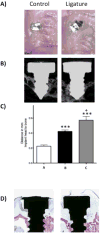Ligature-induced peri-implantitis in mice
- PMID: 25244403
- PMCID: PMC4368501
- DOI: 10.1111/jre.12234
Ligature-induced peri-implantitis in mice
Abstract
Background and objective: Peri-implantitis has a prevalence of 11-47%, involves destruction of peri-implant bone and may lead to implant loss. A detailed understanding of the pathogenesis of peri-implantitis is lacking. The objective of this study was to develop a murine model of experimental peri-implantitis.
Material and methods: Machined, smooth-surface, screw-shaped titanium implants were placed in the healed alveolar bone of the left maxillary molars of C57BL/6J male mice, 8 wk after tooth extraction. Peri-implantitis was induced by securing silk ligatures around the head of the implant fixtures. Implant survival and peri-implant bone levels were analyzed by micro-computed tomography (micro-CT) scans and histology, 12 wk after ligature placement.
Results: Implant survival was 60% (six of 10) for implants with ligatures and 100% (eight of eight) for controls. Micro-CT revealed significantly greater bone loss around the implants that received ligatures and that survived, compared with controls. The radiographic findings were confirmed via histology and toluidine blue staining.
Conclusion: This study describes a murine model of experimental peri-implantitis around screw-shaped titanium implants placed in the edentulous alveolar bone. This model should be a useful tool to dissect pathogenic mechanisms of peri-implantitis and evaluate potential treatment interventions.
Keywords: animal model; bone loss; dental implant; peri-implantitis.
© 2014 John Wiley & Sons A/S. Published by John Wiley & Sons Ltd.
Figures


References
-
- Mombelli A, Lang NP. The diagnosis and treatment of peri-implantitis. Periodontol 2000. 1998;17:63–76. - PubMed
-
- Fransson C, Lekholm U, Jemt T, Berglundh T. Prevalence of subjects with progressive bone loss at implants. Clin Oral Implants Res. 2005;16:440–446. - PubMed
-
- Roos-Jansaker AM, Lindahl C, Renvert H, Renvert S. Nine- to fourteen-year follow-up of implant treatment. Part II: presence of peri-implant lesions. J Clin Periodontol. 2006;33:290–295. - PubMed
-
- Mombelli A, Marxer M, Gaberthuel T, Grunder U, Lang NP. The microbiota of osseointegrated implants in patients with a history of periodontal disease. J Clin Periodontol. 1995;22:124–130. - PubMed
-
- Lindhe J, Meyle J. Peri-implant diseases: Consensus Report of the Sixth European Workshop on Periodontology. J Clin Periodontol. 2008;35:282–285. - PubMed
Publication types
MeSH terms
Substances
Grants and funding
LinkOut - more resources
Full Text Sources
Other Literature Sources

